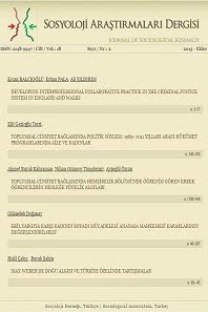GENDER DIFFERENCE IN INTERNAL EDUCATIONAL MIGRATION: DISTANCE ANALYSIS BETWEEN HOMETOWNS AND UNIVERSITIES OF ISTANBUL
Anahtar Kelimeler:
Educational migration, distance analysis, gender, Istanbul, Educational migration, distance analysis, gender, Istanbul
GENDER DIFFERENCE IN INTERNAL EDUCATIONAL MIGRATION: DISTANCE ANALYSIS BETWEEN HOMETOWNS AND UNIVERSITIES OF ISTANBUL
University education is one of the primary incentives for internal migration and most educational migration in Turkey is directed toward the city of İstanbul. In addition to vocational and academic achievement, university education also provides autonomy for young people by allowing them to live in different and perhaps distant areas from their families. In this article, we analyze students who have moved to İstanbul with regard to characteristics of gender and migratory distance in order to determine whether there is a gender difference in the realization of distant resettlement for education. To accomplish this, we use a database of students in the 2017-2018 academic year who applied for accommodation to the General Directorate of Credit and Hostels (KYK), which is the largest public institution that provides housing opportunities for university students in Turkey. This dataset includes 27,643 students, 49% of whom are female while 51% are male. Controlling for the demographic, social, and economic characteristics of the students and their scores on the university entrance exam, we reveal that male students move greater distances to study in universities and they have more opportunities to migrate to İstanbul from settlements farther away than female students.
Keywords:
Educational migration, distance analysis, gender, Istanbul,
___
- Agasisti, T. and Dal Bianco, A. (2007). Determinants of college student migration in Italy: Empirical evidence from a gravity approach. SSRN. dx.doi.org/10.2139/ssrn.1063481.
- Alm, J. and Winters, J. V. (2009). Distance and intrastate college student migration. Economics of Education Review, 28, 728-738.
- Berker, A. (2009). The impact of internal migration on educational outcomes: Evidence from Turkey. Economics of Education Review, 28, 739-749.
- Bingöl, Ş. (2019). Gender difference in internal educational migration: Distance analysis between hometown and university for students applied for residing in the dormitories of General Directorate of Credit and Hostels. Unpublished master's thesis, Hacettepe University, Institute of Population Studies, Ankara.
- Büyükuysal, M.Ç. and Öz, İ.İ. (2016). An alternative method to least squares in presence of multicollinearity: ridge regression. Journal of Duzce University Health Sciences Institute, 6(2), 110-114.
- Brooks, R. and Waters, J. (2011). Student mobilities, migration and the internationalisation of higher education, Basingstoke: Palgrave MacMillan.
- Cairns, D. and Smyth, J. (2009). I wouldn’t mind moving actually: Exploring student mobility in Northern Ireland. International Migration, 49(2), 135-161.
- Courtois, A. (2019). From ‘academic concern’ to work readiness: student mobility, employability and the devaluation of academic capital on the year abroad. British Journal of Sociology of Education, 40:2, 190-206.
- Curran, S. R., Shafer, S., Donato, K. M. and Garip, F. (2006). Mapping gender and migration in sociological scholarship: Is it segregation or integration?. International Migration Review, 40 (1): 199-223.
- Dustmann, C. and Glitz, A. (2011). Chapter 4 - Migration and Education. Handbook of the Economics of Education, Elsevier, 4, 327-439.
- General Directorate of Highways, Distance Calculator, http://www.kgm.gov.tr/Sayfalar/KGM/SiteEng/Root/DistanceCalculator.aspx [Access Date: 28.02.2019].
- Günay, D. and Günay, A. (2011). Quantitative developments in Turkish higher education since 1933. Journal of Higher Education and Science, 1(1), 1-22.
- Higher Education Information Management System, https://istatistik.yok.gov.tr/ [Access Date: 05.04.2019].
- Işık, Ş. (2009). Türkiye’de eğitim amaçlı göçler. Coğrafi Bilimler Dergisi, 7(1), 27-37.
- Kmiotek-Meier, E. and Karl, U. (2016). Student mobility in Luxembourg. Technical Report of EU’s Project “MOVE: Mapping mobility – pathways, institutions and structural effects of youth mobility in Europe, H2020”, 111-177.
- Leathwood, C. and Read, B. (2008). Gender and the changing face of higher education: A feminized future?. UK: McGraw-Hill Education.
- McCarthy, E.M., Sen. A.K. and Garrity F.B. (2012). Factors that influence Canadian students’ choice of higher education institutions in the United States. Business Education & Accreditation, 4 (2), 85-95.
- McQuaid, R. and Hollywood, E. (2008). Educational migration and non-return in Northern Ireland. Report prepared for The Equality Commission for Northern Ireland, Section 2: Patterns and trends of educational migration, 23-40.
- Miller, J. S. (2006). The method of least squares, Accessed from Williams College webpage: https://web.williams.edu/Mathematics/sjmiller/public_html/BrownClasses/54/handouts/MethodLeastSquares.pdf.
- Mixon, F.G., Jr. (1992) Factors affecting college student migration across states. International Journal of Manpower, 13(1), 25-32.
- Raghuram, P. and Sondhi, G. (2021). Gender and international Student migration. The Palgrave Handbook of Gender and Migration (p.221-235). UK: Palgrave MacMillan.
- Sà, C., Florax, R. J. G. M., and Rietveld, P. (2004). Determinants of the regional demand for higher education in the Netherlands: A gravity model approach. Regional Studies, 38(4), 375–392.
- TURKSTAT, (2000). General Population Census.
- TURKSTAT, (2011). Population and Housing Census.
- TURKSTAT, Data Portal for Statistics, Population and Demography. https://data.tuik.gov.tr/Kategori/GetKategori?p=nufus-ve-demografi-109&dil=1 [Access Date: 21.06.2021].
- Uysal, M. and Günay, S. (2001). Some tests for negative autocorrelation in the inconclusive area according to the Durbin-Watson criterion. Anadolu University Journal of Science and Technology, 2(2), 277-284.
- Valverde, J.R. and Vila, M.R. (2003). Internal migration and inequalities: The influence of migrant origin on educational attainment in Spain. European Sociological Review, 19(3), 299-317.
- Williams, N. (2009). Education, gender, and migration in the context of social change. Social Science Research, 38, 883-896.
- Yüksek Öğrenim Kredi ve Yurtlar Kurumu Yurt İdare ve İşletme Yönetmeliği (2016, 9 Ağustos). Resmi Gazete (Sayı: 29796). Erişim Adresi: https://www.resmigazete.gov.tr/eskiler/2016/08/20160809-14.html.
- ISSN: 2148-9947
- Yayın Aralığı: Yılda 2 Sayı
- Başlangıç: 2010
- Yayıncı: Sosyoloji Derneği
Sayıdaki Diğer Makaleler
ETNOGRAFİK ARAŞTIRMALARA İLİŞKİSEL SOSYOLOJİNİN KATKILARI
ISTANBUL CAB DRIVERS AND DISPUTE RESOLUTION: A STUDY OF LEGAL CONSCIOUSNESS
Arda İBİKOĞLU, Eyüp Mert BİRDAL, Enes KURUÇAY
ÇAĞDAŞ SOSYOLOJİK İKİLEMLER İÇİN BİR MİLAT: PARSONS-SCHUTZ TARTIŞMASI
COVID-19 PANDEMİSİ KOŞULLARINDA YAŞLILARIN TOPLUMSAL DAYANIŞMASI: MUĞLA TAÜ ÖRNEĞİ
NARRATIVES ABOUT MENSTRUATION IN TURKEY: SELF-SHAME, SUPPRESSION AND SILENCE
TÜRKİYE’DE SİVİL DİN: ENGELLER VE FIRSATLAR
MARMARİS'TEKİ OTEL YÖNETİCİLERİNİN KÜLTÜREL YATKINLIKLARININ BOURDIEUCÜ BİR ANALİZİ
Selma TATAR, Vefa Saygın ÖĞÜTLE
ŞİDDET KAVRAMI ÜZERİNE NİTEL BİR ARAŞTIRMA: BURDUR MEHMET AKİF ERSOY ÜNİVERSİTESİ ÖĞRENCİLERİ ÖRNEĞİ
